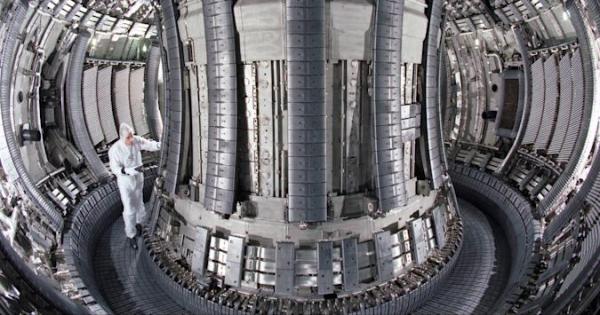
The Joint European Torus (JET) fusion reactor near Oxford in the UK has produced the highest level of sustained energy ever from atom fusion, Nature has reported. On December 21st, 2021, the “tokamak” reactor produced 59 megajoules of energy during a five second fusion pulse, more than double what it managed way back in 1997.
“These landmark results have taken us a huge step closer to conquering one of the biggest scientific and engineering challenges of them all,” said Ian Chapman, lead of the Culham Centre for Fusion Energy (CCFE).
The JET reactor is the flagship experimental device of the European Fusion Program (EUROfusion) funded by the EU. It’s mainly designed to help scientists prove that their modeling is correct, with an eye toward future experiments with the much larger ITER reactor being built in France, set to start fusion testing in 2025. “JET really achieved what was predicted. The same modelling now says ITER will work,” fusion physicist Josefine Proll (who is not involved with JET) told Nature.
The experiment pushed the reactor to its “absolute maximum,” said CCFE plasma scientist Fernanda Rimini. JET used a mixture of deuterium (aka heavy water) and tritium, the same fuel mix that will power ITER. Tritium is a radioactive hydrogen isotope that generates more neutrons when fused with deuterium than deuterium fused with itself, increasing energy output. The researchers also replaced the tokamak’s inner wall to reduce tritium waste.
JET hit a Q value of 0.33, meaning it produced about a third of the energy put in. The highest Q value achieved so far is 0.7 by the US Department of Energy’s National Ignition Facility, but it only hit that figure for 4 billionths of a second. The goal with ITER is to reach a goal of Q factor of 10 or greater, while creating 500 MW of power for long 400 to 600 second pulses. ITER will not produce net energy in the form of electricity, but will pave the way for future machines that can.
Before that happens, however, researchers must solve several challenges. Principally, they have to deal with the heat created in the exhaust region of ITER, as it will be much greater proportionally than with the JET reactor. Still, the experiment’s success allowed the team to glean a wealth of information that can be analyzed over the next few years. “If we can maintain fusion for five seconds, we can do it for five minutes and then five hours as we scale up our operations in future machines,” said EUROfusion program manager Tony Donne.









